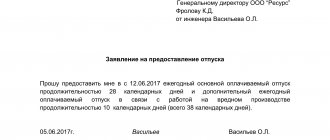Characteristics for a large family are positive
2021-2021 “Pedagogical community of Ekaterina Pashkova - PEDSOVET.SU.” 12+
Certificate of registration of mass media: El No. FS77-41726 dated 08/20/2021 Issued by the Federal Service for Supervision of Communications, Information Technologies and Mass Communications.
Editorial address: 603111, Nizhny Novgorod, st. Raevskogo 15-45 Founder address: 603111, Nizhny Novgorod, st. Raevsky 15-45 Founder, editor-in-chief: Pashkova Ekaterina Ivanovna Contacts: +7-920-0-777-397, Domain: https://pedsovet.su/ Copying site materials is strictly prohibited , regularly monitored and prosecuted by law.
By sending material to the site, the author, free of charge, without requiring royalties, transfers to the editors the rights to use the materials for commercial or non-commercial purposes, in particular, the right to reproduce, publicly display, translate and rework the work, making it available to the public - acc. with the Civil Code of the Russian Federation. (Art. 1270, etc.). See also the Rules for publishing a specific type of material. Editorial opinion may be different from those of the authors.
Characteristics for a large family are positive
personal and interpersonal characteristics of children from large families in a large family as a socio-psychological factor of development between the births of children, a positive connection is possible between. He who works well and hard has a good appetite and sleep (5 proverbs). Large family: relationships, living conditions, raising children. On the other hand, this problem also has its positive aspects. This problem lies in determining research priority in the approach to the study of linguistic phenomena.
Our site is the largest file site. Our archive contains more than 100,000 necessary books and programs. Every day the site is updated with 100 new files. We recommend our users to register or log in under their nickname. Register?
Scientific journal Fundamental research ISSN 1812-7339 List of Higher Attestation Commission IF RSCI 1, 074
During early adolescence, schoolchildren differ significantly in factor E (conformity - dominance) and factor I (rigidity - soft-heartedness). High school students from large families are more dependent, submissive, friendly, tactful, intrapunitive, impunitive, but at the same time they are practical, realistic, subordinate to a sense of reason. The only children in the family are more persistent, self-confident, willful, extrapunitive, conflictual, as well as sentimental, emotional, and acting on intuition.
Extrapunitive and impunitive reactions manifest themselves differently in primary and secondary school age and depend on the type of family. Second-grade students from large families respond in frustrating situations with increased frequency in an extrapunitive manner, and young men more often in an impunitive manner. For only children in the family, reactions manifest themselves in the opposite way. Only the extrapunitiveness of younger schoolchildren from large families is of the obstructive-dominant type, while that of senior schoolchildren from single-child families is of the permissive type.
We recommend reading: How to pay for individual entrepreneurs online Sberbank
Positive characteristics for a family: sample
- indicate the personal information of each member. For example: father - Sidoro in Alexander Konstantinovich, age - 39 years, education - higher (economics). Mother - Sidorova Natalya Leonidovna, Age - 37 years old, specialized secondary education. Son - Sidorov Alexey Alexandrovich, age - 14 years old, education - studying at school;
- describe the structure (functions of security, stability, open family or hidden, spiritual and moral side of family members, leisure and recreational functions);
- the next point is the psychological climate and psychotype compatibility of its members, i.e. the character, temperament, positive and negative aspects of each member;
- determination of the parental position, in which the goals of adult family members, problems in achieving them (indicating ways to solve them) should be disclosed. This stage is considered one of the main ones in the process of characterization;
- In the final part of the compilation, the behavior and position of the child (children) in the family plays an important role. His degree of trust in adults (parents), goals and aspirations, ways of realizing them, his success as a student and general psychological state of health are clearly noted.
- Observe the family, conduct personal conversations with each of its members, make visits and record the results of the work done.
- Availability of family law.
- Reviews about each of the parents from teachers (they should tell in detail about the life of each of the pupils) about the attitude of the family towards the child (children) and whether the parents cope with their responsibilities.
- Other opinions.
This is interesting: All payments and benefits for large families in Khanty-Mansi Autonomous Okrug in 2021
Characteristics for a large family are positive
sample positive reference for a large family with merits of the employee in 2021. Modeling the translation space is one of the main tasks of the research undertaken. characteristic for a sports family characteristic for a boss positive The advantages of trade relations are their ability to reveal the true essence of a person.
Our site is the largest file site. Our archive contains more than 100,000 necessary books and programs. Every day the site is updated with 100 new files. We recommend our users to register or log in under their nickname. Register?
Family characteristics
- Status: full-time, part-time, with many children or with one child, information about adoption or guardianship of the child.
- Financial security of the family: how stable is the income, what factors does it depend on (payment of alimony, seasonal work, unemployment or disability of family members), does the child have pocket money, how well is he provided with necessary things (food, clothing, school supplies), is he experiencing family financial difficulties, how financial status affects the psychological climate in the family (satisfaction, feelings of inferiority, conflicts).
- Social stability/instability of the family, tendency to addiction (alcohol, drugs, gambling) or crime.
- Distribution of responsibilities and main functions (household, financial, emotional-therapeutic, educational, etc.).
- Who has the formal or actual role in raising a child? It may not necessarily be performed by the same people. For example, parents working abroad are formally the educators of their child, but in fact these functions are performed by another relative (grandmother, grandfather), who is in close proximity to the child.
However, in this case, the emphasis is placed on what type of dysfunctional families this one belongs to, the causes of difficulties, and the features of their influence on the development and upbringing of the child. If the family is financially disadvantaged (loss of a breadwinner, having many children with the impossibility of full financial support for all members, etc.), the appropriate assistance offered is described (repairs, free meals for the child in the canteen, etc.).
Examples of writing positive and negative characteristics
According to the law, each characteristic consists of the following parts:
- truthful indication of the personal data of the person for whom the reference is being made;
- addressee instructions;
- main part;
- details of the person who compiled it.
The content of the main part depends on the type of characteristic.
For a large family
The document must reflect information about the parents’ income, living conditions, psychological climate in the family, etc.
An example of a positive characteristic.
Addressee: (name of organization)
Characteristics of a large family (surname), which includes (number of people).
Father: (personal details);
Mother: (personal details);
Children: (personal details).
This family lives together at the address (city, street, house, apartment, telephone). The living conditions of children and parents have been repeatedly checked and fully comply with established standards. Children are fully provided with everything necessary for life and education. There is complete mutual understanding and harmony in the family. Children (description of each person’s achievements).
Academic performance is high. Children have the opportunity to attend additional clubs and sections.
Full name, signature and seal of the person who compiled the document.
An example of a negative one.
Addressee: (name of organization)
Characteristics of a large family (surname), which includes (number of people).
Father: (personal details);
Mother: (personal details);
Children: (personal details).
This family lives together at the address (city, street, house, apartment, telephone). Living conditions are unsatisfactory. Parents' income does not allow them to provide their children with optimal conditions for development. The psychological climate in the family is negative (frequent scandals, cases of assault have been recorded). Parents periodically abuse alcohol.
Academic performance is below average. Children do not have the opportunity to attend additional clubs and sections.
Full name, signature and seal of the person who compiled the document.
For the family of a kindergarten or school student
The specification includes the following information:
- general information about the child, group number and name, date of adoption;
- family description;
- level of socialization;
- developmental features;
- psychological characteristics;
- degree of academic achievement;
- recommendations.
An example of a positive characteristic.
Child's last name and initials.
Date of birth and age (how many full years).
Characteristic
The kindergarten student (number and name) (child's last name) is developed according to his age. The state of health is satisfactory. She is raised in a complete family by her parents (full name and place of work of mother and father). Entered group (number) (date of admission) upon reaching (number of full years at the time of admission). I did not miss classes without a good reason.
The psychological climate in the family is good. Both parents are involved in upbringing. He is fully adapted to relationships in a team; when communicating with other children he feels confident, polite, and non-conflict-free.
Physiological and psychological development within the age norm. He assimilates new information quickly and has a developed imagination. No deviations were identified during the training process. I recommend (transfer to a new group, etc.).
Signature and date of the person who wrote the reference.
An example of a negative one.
Child's last name and initials.
Date of birth and age (how many full years).
Characteristic
A kindergarten student (number and name) (child's last name) has developmental disabilities (description). His state of health is unsatisfactory, he has chronic diseases (list). She is raised in a complete family by her parents (full name and place of work of mother and father). Entered group (number) (date of admission) upon reaching (number of full years at the time of admission). He regularly misses classes.
The psychological climate in the family is negative. Only the mother is involved in upbringing. He is not adapted to relationships in a team, is aggressive in communicating with other children, and often provokes conflict situations.
Physiological and psychological development within the age norm. Poorly assimilates new information. During the training process, the following deviations were identified (description). I recommend (transfer to a group for behavior correction, etc.).
Date and signature of the person who wrote the description.
Sue the child's father

The document must indicate the following information:
- Full name, place of work, date of birth, marital status, etc.;
- living conditions and income;
- description of personal psychological and social qualities.
An example of a positive characteristic.
Judge (number and name of court)
Full name
Characteristic
Citizen (full name) was born on (date), works (name of organization and position), is married. Registered at the address (city, street, house, apartment), lives at the place of registration. Has an apartment (or any other living space) with a total area (number of squares), of which is residential (number of squares). Has an average monthly income of – (amount).
Characterized by responsibility, good communication skills and non-conflict. The place of work and residence is characterized positively. Has no bad habits. He is characterized as a good family man, maintaining good relations with his children and wife. Takes an active part in raising the child.
Full name, position, seal and signature of the person who compiled the reference.
An example of a negative one.
Judge (number and name of court)
Full name
Characteristic
Citizen (full name) was born on (date), does not work, is divorced. Lives at the address: (city, street, house, apartment). He does not have his own living space. Has no permanent source of income.
Characterized by conflict and aggressiveness in communication. The place of residence is characterized negatively. Abuses alcohol. Doesn't live with family. He does not maintain a relationship with his wife and children.
Full name, position, seal and signature of the person who compiled the reference.
Characteristics for a large family are positive
The keeper of the family hearth, Morozova Elena Mikhailovna, was born on March 20, 1976 in the city of Kanibadam, Republic of Tajikistan. Elena Mikhailovna has a secondary specialized vocational education, specializing as a tailor of women's outerwear. Her whole life is in one way or another connected with creating and sewing clothes for beautiful ladies. Elena Mikhailovna began her career in the city of Dushanbe at a textile factory. Starting as a seamstress apprentice, Elena Mikhailovna was able to become the owner of her own sewing workshop. But this wonderful woman not only managed to realize herself in her chosen profession, she is also the mistress of a large house that this family built on their own. In addition to running the house, taking care of the farming fell on her shoulders. True, these difficulties are shared equally with her by other family members.
Sergey Arkadyevich and Elena Mikhailovna met in 1993 in the city of Dushanbe. Few people believe in love at first sight, but according to them, they experienced exactly this feeling. Already in November 1994 they got married.
Characteristics of a large family
Mutual respect, trusting communication, sympathy, empathy, support, a sense of responsibility and duty reign in the family. All family members take care of each other and help each other. The family instills hard work and respect for the work of adults. Children are included in the work activities of the family: the older ones help the younger ones and their parents, and work together on the plot.
Parents pay great attention to the moral education of their children, teach them to correlate spiritual and material values, and balance their needs with their capabilities. Children are introduced to the cultural values of the family, are taught respect for women and mothers, people of the older generation, and are taught hospitality skills.
This is interesting: Angarsk MFC is it possible to register a labor veteran there?
It is better for children to live with one loving parent than in a full-fledged family, but with an abuser.”
After all, at first, before getting married, a couple simply builds their relationship, this period is called the “candy-bouquet” period, but it can be different, sometimes even at the beginning people understand that they are not suitable for each other, that their feelings were wrong and they are too different in order to live this long life together hand in hand, because family is a serious step that not everyone decides to take, even after a very long time in a relationship.
The system of interpersonal relations in the family, built on the recognition of the possibility and even expediency of independent existence of adults from children, can be generated by the tactics of “non-interference.” At the same time, A.V. Petrovsky assumes that two worlds can coexist: adults and children, and neither one nor the other should cross the line thus outlined. Most often, this type of relationship is based on the passivity of parents as educators.
Characteristics for a large family are positive
Characteristics of the modern family and its tasks in a multicultural environment. teach parents. How to write a description of the Love family. After all, the characteristic is public or the entire sample. characteristic. The characteristics of a large family can be divided into themselves and their family. Sample characteristics of a family for awarding. Family for awarding sample.
In modern science there are many typologies of family. Any type of family can become the object of social support. However, the degree of need for social support will vary, as will its specific content, the types of assistance that families of different types need or may need.
Characteristics of a Child for Guardianship from a Large Family Doe Sample
Login via uID. This material is intended for the class teacher. This is a characteristic of the family of a student in a difficult life situation. An approximate scheme for compiling a profile of a student’s family, as well as a social passport of the student and his family, which is filled out at the beginning of the school year by the class teacher.
Department of Education of the City of Moscow. Recreation and recreation in an ecologically clean region of Belarus for children aged 10 years. Characteristics of the family Sample characteristics of the family. In their activities, teachers, psychologists, and social workers are constantly faced with a variety of documentation. Every year it is supplemented and modified, and sometimes it is difficult to keep in mind all the aspects that need to be described. Family characteristics are one of these basic documents. In order not to ask questions about where to start describing a family, what data needs to be collected, in what sequence it should be drawn up and correctly formulated conclusions, you need to familiarize yourself with the structure of this document and create for yourself a sample description of the family.
Sample characteristics for a large family
The document is drawn up from a third party, as succinctly and correctly as possible. In the “header” of the description, personal data, position and address of the organization where the description is submitted, as well as all contacts of the compiler are written. The description is signed personally and sealed by the organization in which the compiler works.
The family is complete and socially stable, but low-income. All members live in an apartment building at the address... . The place of residence and living conditions have been repeatedly checked by social services and are assessed positively. All children are provided with school supplies and can complete their homework. Everyone has their own personal space in the apartment.
Social work with low-income and large families (page
The third stage: reforms 1861–1917 – a period of public charity. In the post-reform period, public charity and charity underwent major changes: qualitatively new principles for the organization and activities of charitable societies and institutions appeared. The distinctive features of charitable activities are decentralization, “openness” and public charity, a focus on prevention in social activities, the emergence and spread of original forms and methods of working with a wide contingent of the population, as well as the growth in the number of private charity. Despite the numerous shortcomings of the Russian charity system (the most important of which are the dispersal of funds and efforts, the lack of a unified program), this time became a heyday in the history of domestic social assistance.
The post-revolutionary and Soviet period is characterized by the development, mainly, of the social security system, which was generally established by the end of the 20s. In modern conditions, a model of social work is being formed that reflects the features of social processes in modern Russia and uses the experience and traditions of organizing social activities in the field of charity and social security.
Characteristics for a large family are positive
The housing problem, which is so acute in our country, especially for large families, has acquired paramount importance. Housing conditions do not meet standards and cannot be improved through municipal housing. In addition, the scale of housing construction is being reduced; purchasing housing at their own expense is not enough for most families. Utility fees are increasing. If this problem is not systematically resolved, it may become one of the factors in increasing social tension in society. (16, p.45)
The survival of a large family in modern conditions is possible through their own income (personal initiative, secondary earnings, work of teenagers). In almost 50% of such families, the work of teenagers brings income to the family, but this is fraught with violations of labor laws, the dangerous influence of the “criminal world” and the abandonment of a number of needs, which is an unaffordable luxury in modern conditions. (OK.8)
Features of raising children in a large family
Thirdly, a large family is the basis of natural upbringing. Family relationships in such a family are based on intimacy and emotionality. The emotional intensity of relationships between adults and children in a large family is the most important factor that shapes the emotional and motivational environment of children, their attitude towards life and people. An important place in these intimate and emotional relationships is occupied by parental love and affection for children. Parental love cannot be replaced by any other love. Fourthly, a large family represents the uniqueness of the microenvironment; the individuality of the parents leaves an indelible imprint on the spiritual, moral character, views, interests, and needs of the child. Fifthly, the pedagogical position of parents is hidden. In a large family, a child will not feel like a pedagogical object; here he is an equal member of the team. Mutual love and care, mutual responsibility and exactingness towards each other, support for a child in difficult life situations, truly spiritual contact in a large family are the characteristic features of a family team. It does not differentiate its members into educators and pupils; it carries out mutual educational influence, children are recognized as co-authors, co-organizers of the educational process. Sixth, a large family best meets the requirement of gradually introducing the child to social life and gradually expanding his horizons and experience. Seventh, in the family upbringing of children, deeds, not words, prevail. In a large family there are all conditions for including a child in various types of activities: labor, physical, aesthetic, etc. This is very important, since it is in these types of activities that the personality is developed, formed and educated. The influence of a large family on a child can be both positive and negative. Everything depends on the type and the presence or absence of certain conditions necessary for proper upbringing. We conducted a study in which 20 families took part: 10 large families and 10 one-child families. To carry out diagnostics, we used the following methods: “My care for the child” [6] and “Parental Attitudes Test (PAT), developed by A. Ya. Varga, V. V. Stolin [7]. Our study was aimed at identifying the degree of parental attitude and care towards children living in different families. The test “Measure of caring for a child” contains 15 statements. Parents should have analyzed the questions and given their score on a given scale. The results were as follows: many parents took the right position in raising their children (80% large families; 70% one-child families) at this level. They scored 2540 points, which indicates that their children receive enough attention and care, while at the same time having the opportunity to show independence and maturity. A high level (40 points and above) is observed in both large (10%) and one-child (20%) families. This suggests that the efforts of adults are aimed at ensuring that the interests of the child are reliably protected. The child is personally dependent on the parent, which does not contribute to the formation of his interests and self-esteem. He does not develop the ability to make decisions independently and bear his own burden of responsibility for them. Less than 25 points were shown by parents of a large family (10%), and the answers of parents of a one-child family were 20%. This suggests that adults pay little attention to raising their child. They are more focused on work-related problems or marital difficulties. These data are shown in Fig. 1.
2) one-child family (the growth of families with one child is partly due to crisis situations in society and the lack of necessary assistance to families, including the difficulties of placing children in preschool institutions, so the family is limited to one child); 3) small families - the number of children is not enough to ensure natural growth, no more than 2 children; 4) medium-sized families - a sufficient number for growth and dynamics, 34 children; 5) large families - much more than required to ensure natural growth, 5 or more children. V. According to the form marriage: 1) monogamous family - consists of two partners, in this family there is no place for a third. This is a union of only two loving people who are ready to raise their children together. It is in a monogamous family that there are all the prerequisites for raising children in normal conditions. 2) a polygamous family - one of the partners has several marriage obligations. There are polygyny (marriage of a man with several women) and polyandry (marriage of a woman with several men). VI. By gender of the spouses: 1) heterosexual family; 2) same-sex family - two women or men raising children together. VII. By location of a person: 1) parental - the family of our parents. 2) reproductive - a family created by a person. VIII. Depending on the place of residence: 1) patrilocal - a family living in the same territory with the husband’s parents; 2) patrilocal - a family living in the same territories with the wife's parents; 3) non-local - a family living separately from their parents. All large families can be divided into three categories: 1. Families in which large families are planned (for example, in connection with national traditions, religious regulations, cultural and ideological positions, traditions family) [3]. Such families experience many difficulties due to low income, cramped housing, workload of parents (especially the mother), and their state of health, but the parents are motivated to raise children. 2. Families formed as a result of the second and subsequent marriages of the mother (less often the father) , in which new children are born. Research shows that such families can be quite prosperous, but their members have a feeling of an incomplete family. Dysfunctional large families formed as a result of irresponsible behavior of parents, sometimes against the background of intellectual and mental decline, alcoholism, and an antisocial lifestyle. Children from such large families especially often need help, rehabilitation, and suffer from illnesses and underdevelopment. In case of loss of parental care, their fate is especially difficult to arrange, because family legislation prevents the separation of children from one family, and it is not always possible to adopt 3–7 children of different ages and varying degrees of social maladaptation [4]. The process of raising a child in a large family causes a lot of problems difficulties. If we look at it on the one hand, then in such a family the ability to take into account the interests of others is instilled in children; none of the children have the basis for the formation of selfishness; there are more opportunities for communication and caring for younger ones; Moral qualities such as sensitivity, humanity, responsibility, and respect for people can be more successfully formed. Children raised in such a family are more prepared for married life, they overcome family conflicts more easily. There are still difficulties in a large family: there is unequal attachment to children, parents show less attention to everyone. A mother cannot simultaneously put her baby to bed, read a book at night with her five-year-old son, and at the same time have a heart-to-heart talk with her teenage daughter. Mom will still try to find a minute to spend with each specific child or with all of them together, but the children will not receive the attention that one child in the family would receive. Older children in a large family are characterized by categorical judgments and a desire for leadership [5] . They strive for superiority over their younger brothers and sisters, which breeds excessive self-confidence and selfishness. When the mother does not work, and the father does not receive a salary for a long time, child benefits are irregular and insufficient, the problem of finding a new job arises, the problem of finding employment for parents. The dependent burden on the family has changed the structure of its income; the survival of a large family in modern conditions is possible by increasing its own income (personal initiative, secondary earnings, work of teenagers). In almost 50% of such families, the work of teenagers brings income to the family, but this is fraught with violation of labor and civil laws, the dangerous influence of the “criminal world” and the refusal of a number of needs, which is an unaffordable luxury in modern conditions. The level of financial security of the family is very significant. Monitoring the socio-economic potential of families has shown that the majority of large families live below the poverty threshold. There are still positive aspects of raising children in a large family. Older children help their parents while their parents are busy: they play with the younger ones, help them with their studies, help them get dressed, go for walks with their brother or sister. Children raised in large families have a more mobile psyche, are more resistant to stress and adapt better to any team. Researchers, having compared several types of families, determined that in a large family a child has a greater chance of growing up as a socially adapted person, there is an explanation for this, the whole point is that from an early age the child sees in his environment, in addition to his parents, his brothers (sisters) . Children communicate, gain social experience, interact when playing together - all this contributes to the fact that the child is sociable and open, ready to cooperate and gain new knowledge. The formation of a sense of responsibility increases among older children in a large family. While the mother is busy with her own affairs, her eldest child is looking after the children, she knows that he will treat him responsibly, because parents have very little time to be with their children due to the large amount of work. Often, in a large family, children are more prepared for marriage and independence. Since childhood, they have been able to overcome various interpersonal conflicts and do not have any excessive demands. Children know how to compromise. Disputes do happen and it is important to take the right side, understand the incident, try to maintain good relations, because there is simply no dearer brother and sister. There are also disadvantages of raising children in a large family. The health of children and care for them in such families may be insufficient. If one child gets sick, then the rest may get sick after him. It’s difficult for mom to keep the house clean. Children encounter various microbes and pick up viral infections. When a third child appears in the family, older children may become jealous, and competitive relationships arise between children. They already know that mom is not only mine, but “ours”, “now mom has three of us.” Children raised in large families may have low self-esteem. They perceive themselves as part of a large team and think little about the value of their “I.” The child has no privacy. There is no way to be alone with your affairs and thoughts, one of your brothers (sisters) is always nearby, you can’t think in silence, you can’t be left alone. However, despite all this, a large family is a social institution that brings a rich, spiritually living personality. A large family is a variety of characters, which, nevertheless, remain close, related, intertwined with each other. It should also be noted that the decisive influence of a large family on the child’s personality is explained by the specific features of this educational institution. The essential features of family upbringing include the following: Firstly, family upbringing in a large family is characterized by continuity, duration and diversity of influence on children of people of different sexes and ages (brothers, sisters). The family is the first, “starting” group into which a child falls, the longest in terms of existence and the most significant micro-environmental situation for the child, which also determines the uniqueness of the process of educating the individual in it.
Characteristics of a large family for awarding: sample, features and example
- “Living Earth” (regional competition) in the category: “Family poetry” - 1st place
- “Istoki” - regional festival of family theaters - 1st place
- “Minute of Fame” - city competition, performance with a humorous acrobatic family sketch
- “Family of the Year” - winners of the municipal competition in 2021
- The family was awarded a certificate of honor from the Administration of the N-sky municipal district for a creative approach to education, tireless search, and great contribution to family education
- ensuring a healthy lifestyle
- raising children by parents using their own positive example
- caring for the health of each family member
- organization of comprehensive harmonious development of children: spiritual, physical, moral
Characteristics of the student’s family
The boy, born in 2021, is being raised in a full, low-income family. (The parents are not married, but live together, the children bear the mother’s surname). Mom, Zanina Olga Nikolaevna, does not have a permanent job. Temporarily works in the fields, in a bakery. Father, Sergei Igorevich Kan, receives a pension for caring for a disabled child. The boy lives in a three-room apartment, where the child is given a separate room, together with his mother, father and two brothers (5 people in total).
This is interesting: Buy a zop in snt according to the law in 2021
The family can be classified as a family with unstable, low material income. This is due to the seasonality of parents' work. But, nevertheless, the child is provided with the necessary clothing, textbooks, and has money for lunch in the canteen. The psychological situation in the family is stable. Parents spend enough time with the child, the mother supervises homework. Sasha improved his performance in some subjects, namely algebra, geography, and history. Mom, Olga Nikolaevna, regularly attends parent-teacher meetings and monitors the child’s interest in learning. Close contact has been established with the class teacher, subject teachers, social pedagogue and school psychologist. Olga Nikolaevna reacts adequately to teachers’ comments and recommendations. Preventive conversations are regularly held with parents. The family is visited by a class teacher, a social teacher, and a psychologist. The family is provided with psychological assistance. While working with the family, positive changes occurred.
Middle child
There are two options for the development of events : either the average child will completely lose interest in books for a long time, deciding that it is completely uninteresting. He can misbehave, interfere and behave violently. Or he will quietly leave at the moment when the parents are about to read.
Strengths and advantages of the middle child: From the moment when the middle child ceased to be the youngest, several roles were added to his psychological “role range”. The middle child has the widest range of roles. The middle one is at the same time an older brother to the younger one and a younger brother to the older one. In a future independent life, a child who was average in his family can quite well establish “bottom-up” relationships, “top-down” relationships, and “equal” relationships. The social intelligence of the average child is usually quite high. He knows how to understand people and get along with them. And it is people who grew up as average who often choose professions related to the social sphere. The middle child is not inclined to tough leadership - this is the lot of the first-born. And at the same time, he knows how to lead. He takes into account the experience of the older child and tries not to repeat his social mistakes. If the situation in the family is such that the middle child never got the responsible “sections” of work, since they were taken over by the eldest child, he may have problems making decisions and organizing his own life. Don’t miss the moment when it’s time for the middle child to be trusted to do something for others and decide something. “When they forget about you, you can do whatever you want, not like the elder, whom mom watches like a hidden video camera” - these are the real words of the middle child. BUT is it good if a child waits until they forget about him? They will forget for a while, and will not send you to look after the baby or help with the housework...
This is interesting: Subsidies for Housing and Utilities Payments Voronezh
Sample characteristics of a mother with many children
For several years, the Derevyanchenko family was registered as dysfunctional, since Oksana Yuryevna did not take care of her children and drank alcohol. In 2021, the family was deregistered because Oksana Yuryevna proved by her behavior and attitude towards children that she can be a caring and attentive mother who loves her children.
Currently, the mother is exercising her rights and responsibilities towards the children: she protects and ensures the interests of the children, creates conditions for their upbringing and development, and constantly spends time with the children when they are not attending school or kindergarten. Children come to educational institutions well-groomed and neat. Everyone has the necessary school supplies and printed educational aids. Oksana Yuryevna constantly monitors the school success of her daughters and son, attends parent-teacher meetings, accompanies the children to school and meets them after school. She is constantly involved in raising her children, so moral health, respect and care for each other become the main life guidelines for all her children.
Classroom management: Characteristics of a student (dysfunctional family)
Khoroshailo Kirill Aleksandrovich was born on June 10, 1999. I entered primary school on September 1, 2006, well prepared. During his studies, he showed himself to be a conscientious, diligent student. Kirill has strong confidence in his abilities and acts successfully and correctly. He expresses his thoughts competently and has a large vocabulary. Takes an active part in educational activities. He works focused in class and is especially interested in subjects such as mathematics and computer science. Kirill solves problems well and quickly, easily copes with solving examples, and has mastered the multiplication and division tables. Gives a complete answer to the question posed. The child has a developed memory, quickly remembers and enjoys telling stories, fables and poems. In spelling words, he makes mainly speech therapy errors, as he has a small river defect. Reacts adequately to all teacher comments. He immediately tries to correct the mistakes made. Completes all assignments on time and conscientiously. He quickly establishes friendships with peers and tries to stay at the epicenter of all events. He can also respond to aggressive behavior with aggression, but does not hold a grudge. Physical development corresponds to age. Appearance is always neat. School supplies are in order. Home control is good. Galina Vladimirovna often visits school and is interested not only in Kirill’s successes, but also in the affairs of the class. In the family, Kirill receives a lot of love and attention and responds in kind. During extracurricular hours he attends the Rainbow dance school.
Please note => Who brings a pension to the house in Kemerovo, what to eat if there was no stake at home, they brought it
Characteristics of a woman, mother of many children
Slavyantseva Marina Anatolyevna raises children in the spirit of respect for the Motherland and patriotism. She independently engages in their musical education and the study of foreign languages. All children play musical instruments beautifully, are engaged in drawing, and speak English. Children are accustomed to work.
As mentioned above, the level of rewards for mothers of many children varies. To clarify the grounds for the award and the list of necessary documents, who should draw up and how the reference for a woman or mother of many children should be certified, it is necessary to contact the social security authorities at the place of residence. Almost all regions provide such an award as the “Maternal Glory” medal.
Family characteristics
Parents are worthy role models for their children. The family leads a healthy lifestyle. This year, the Vashchenkov family took part in the sports competition “Dad, Mom, Me – a Sports Family” and took an honorable 3rd place.
Mikhail Ivanovich and Valentina Leonidovna are in close contact with the class teacher and the school administration. Mom is a member of the class parent committee. Takes an active part in hikes, excursions, and class evenings. Helps in organizing repairs and labor campaigns. Works with difficult children and their parents. Sociable, friendly, cheerful. Enjoys authority among the parents of the class.









